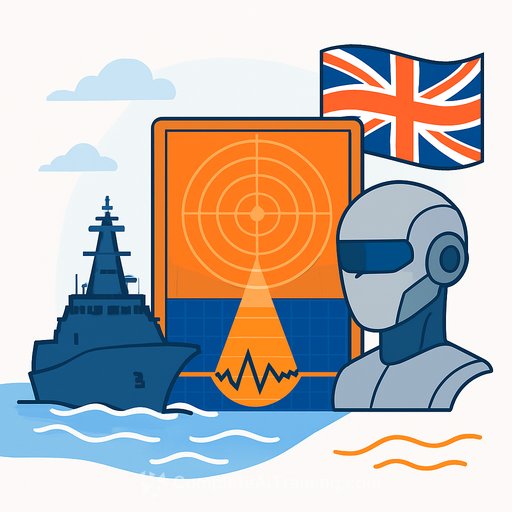UK develops AI-enabled sonar to strengthen Atlantic monitoring
The Ministry of Defence has confirmed progress on AI-driven acoustic detection systems under the Royal Navy's Atlantic Bastion programme-an effort to keep the North Atlantic secure against submarine threats.
Defence Minister Al Carns described Atlantic Bastion as "a portfolio of programmes to secure the North Atlantic for the UK and in support of NATO against a range of underwater threats." The plan enhances existing systems and introduces new platforms to reinforce anti-submarine operations across ships, aircraft, and uncrewed assets.
What's being built
Through AUKUS Pillar 2, the UK, Australia, and the United States are "working together on an algorithm to support Maritime Patrol Aircraft processing systems," according to Carns. The output feeds into a digital targeting web that links sensors, ships, and aircraft-aiming for faster detection, tracking, and handoff across the force.
The Defence Investment Plan will back capability options tied to Atlantic Bastion, with a focus on assets deployable from the Type 26 frigate force. These ships combine advanced sonar, uncrewed vehicles, and digital processing into a flexible architecture that can absorb new AI models and sensor payloads as they mature.
How this maps to an engineering stack
- Signal processing + ML: Beamforming, pattern recognition, anomaly detection, and data association for noisy, variable ocean acoustics.
- Edge AI on constrained hardware: On-aircraft and on-ship inference with tight SWaP budgets; quantization, pruning, streaming inferencing.
- Sensor fusion: Sonobuoys, hull-mounted arrays, towed arrays, and UUV payloads feeding a common track picture.
- Networking: Intermittent, low-bandwidth links across ships, aircraft, and uncrewed systems; smart compression and prioritization.
- MLOps for defense: Model versioning, lineage, red-teaming, and drift monitoring with strict auditability and human-in-the-loop controls.
- Simulation and synthetic data: Scenario generation across sea states, biologics, shipping noise, and adversary countermeasures.
- Interoperability: NATO standards for data formats and messaging to enable combined operations.
- Security: Anti-tamper, secure boot, and adversarial robustness against spoofing and deceptive acoustics.
Type 26 as the integration hub
The Type 26 frigate sits at the center of the Bastion framework. With a flexible mission bay and digital architecture, it can deploy autonomous underwater vehicles, integrate new sensor arrays, and run AI-enabled processing as software modules-shortening the path from R&D to sea trials.
This adaptability is key for rolling updates: swap in a new UUV, update a fusion model, patch a classifier, and push to the fleet without a full system redesign.
Why this matters for IT and development teams
- Real-time constraints: Low-latency pipelines for detection-to-track confirmation under variable compute and bandwidth conditions.
- Reliable data engineering: Streaming ingestion, event ordering, and loss-tolerant protocols across contested environments.
- Governance: Clear rules for when automation assists vs. defers to operators, with explainability and trusted UI feedback.
- DevSecOps at sea: Containerized services, zero-trust controls, and over-the-air updates that won't break mission-critical loops.
- Test at scale: Closed-loop simulation that mirrors ocean noise and adversary tactics before you touch a live hull.
International cooperation
Carns said UK participation in AUKUS technology programmes-combined with NATO cooperation in the North Atlantic and Baltic-will ensure British forces "remain at the forefront of acoustic detection and underwater surveillance capabilities." For developers, that means aligning with shared standards and APIs that make multi-nation data fusion and tasking practical.
What to watch next
- Operational testing of AI models on Maritime Patrol Aircraft and their handoff to shipboard systems.
- UUV integration patterns: payload standards, autonomy levels, and telemetry workflows.
- Model governance playbooks for deployment across mixed security domains and partner fleets.
Learn more about the policy and platform context:
If you're building in this space and want to sharpen your stack-signal ML, edge inference, and MLOps for complex systems-explore curated training for developers and data teams: AI courses by job.
Your membership also unlocks:






